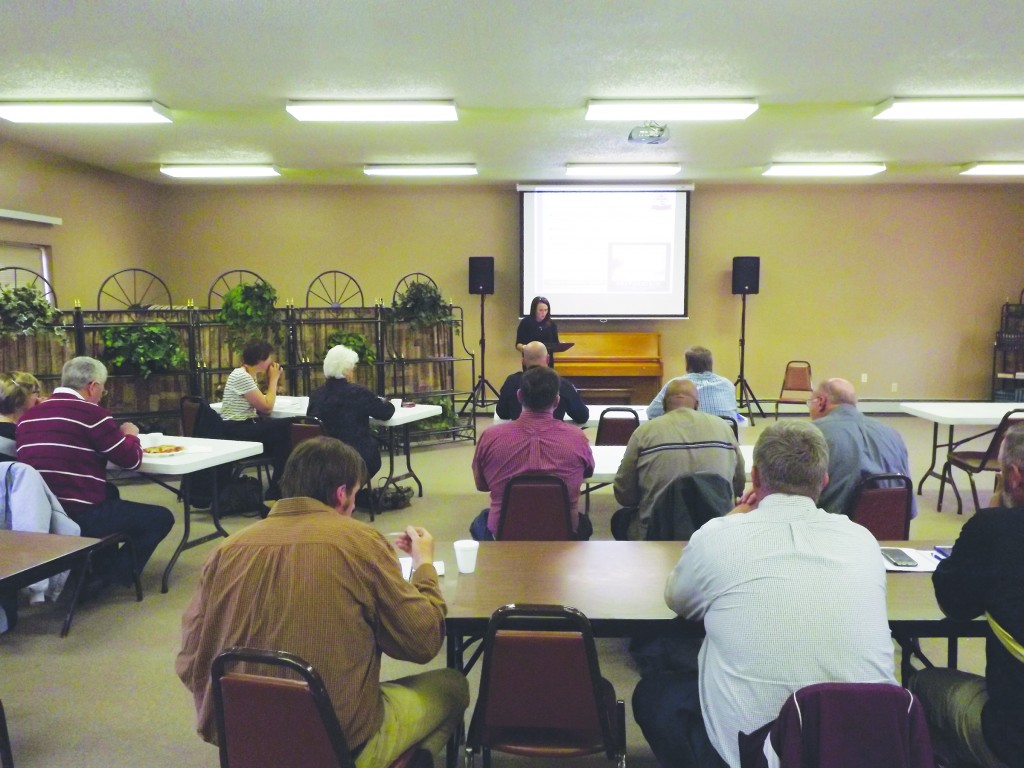San Luis Valley VOAD expanding disaster efforts

MONTE VISTA— The national organization, Voluntary Organizations Active in Disaster (VOAD), is expanding throughout the San Luis Valley region, led by local coordinator Nicolle Rosecrans.
Rosecrans held a meeting in Monte Vista at the Valley Church of the Nazarene last Monday, May 20, with local leaders in the faith community to explain the mission and need for SLV VOAD committee members and specific efforts the faith community and other volunteers can assist in, to ensure local communities take steps to prepare for disasters and respond in the most efficient ways.
The meeting was attended by Rio Grande County Public Health Director Emily Brown; Sue Davis, a Crisis Emergency Response Team (CERT) certified member and longtime coordinator of volunteer efforts; Monte Vista Police Chief John Rosecrans; Colorado State Patrol Communication Center Supervisor and First Line Leadership Mentor Cameron Decker; Callie Adams with La Puente, which will be the acting fiscal agent for the SLV VOAD, and a dozen church leaders from around the San Luis Valley. Parishes of many faiths and all sizes were represented, from Antonito to South Fork.
According to their website, www.nvoad.org, “National VOAD is an association of organizations that mitigate and alleviate the impact of disasters, provides a forum promoting cooperation, communication, coordination and collaboration and fosters more effective delivery of services to communities affected by disaster.” Rosecrans explained the SLV chapter joins Pueblo, Boulder and Larimer counties with state-recognized associations. The SLV VOAD will be working with local businesses, governments and community groups to achieve the four Cs, “cooperation, communication, coordination and collaboration,” in disaster preparation, response and recovery.
Rosecrans explained organizations, like the churches present but any non-profit organizations or businesses with something to offer are welcome, join the SLV VOAD and identify volunteer capabilities and any special skills. In a disaster, volunteer needs are identified by officials who go to the SLV VOAD for referrals and the VOAD then coordinates volunteer support and activities. Benefits of membership in the SLV VOAD organization include maximizing the impact of volunteers, avoiding duplication of efforts, ensuring continuity needs are met and ensuring volunteer contributions, suggestions and concerns are heard.
There are several committees needing members within the SLV VOAD, including advocacy, disaster health, housing, mass care, volunteer management, communications, donations management, long-term recovery and spiritual care. Rosecrans also explained she will be starting a new committee for psychology first aid; a type of peer support group for first responders and victims to talk about the impact the disaster has had on them. SLV VOAD will hold quarterly trainings for specific needs as the committees determine these needs.
SLV VOAD members are activated through the emergency phone system coordinated through San Luis Valley 911. Decker explained only 10 percent of Valley residents are signed up to receive emergency notifications and encouraged attendees to inform their congregations and friends to sign up at www.slve911.org. SLV VOAD will also communicate needs through Facebook, Twitter, Instagram and a forthcoming website. VOAD and the local dispatch center are working toward a system that reaches cell phones similar to the Amber Alert system, but that will be further down the road.
Rosecrans cited issues with volunteer response to the Spring Creek fire in Costilla and Huerfano counties last summer as examples of the need for VOAD committees and planned responses. In some cases volunteers and organizations prepared food for first responders and victims that was thrown away because it was not prepared in an industrial kitchen, and used clothing and blankets could not be used if they were not vacuum sealed and prepared to Red Cross standards. Attendees similarly said they did not feel communication was clear to donors and volunteers during the fire and they could not easily find out what was needed for first responders and victims. There was also miscommunication and rumors about financial donations not going to meet the immediate needs of fire victims which further complicated efforts.
Rosecrans explained Alamosa County Public Health Director Della Cox-Vierra, along with the Red Cross and students from Regis University completed a study of the food preparation facilities of local churches in the region and found only the Valley Church of the Nazarene had a sufficient industrial kitchen and eight others had home-style kitchens which can meet smaller specific needs as well. Churches are also essential in gathering financial donations, which when available are the most efficient means of getting direct aid to those in need. Adams explained that during the Spring Creek Fire financial donations were essential for purchasing plane tickets for displaced victims to go to family members or for hotel rooms for victims. When financial donations are not a possibility, churches and faith groups are essential to providing housing and food for individuals and families when disaster strikes, Rosecrans added.
Any specialized skills and rapid responses are equally as appreciated as financial donations, Rosecrans explained, discussing the need for filling sandbags due to imminent flooding in Lake City following winter avalanches in the area as an example. VOAD uses state databases and partners with other organizations like the Medical Reserve Corps to track volunteers with specialized skills like medical training.
Efforts to fill thousands of sandbags in Hinsdale County and Lake City were completed over Memorial Day Weekend, in part with members of the SLV VOAD including Rosecrans, who stated over 200 volunteers put in over 700 total hours, displaying the success of coordinated disaster efforts.
Updates on the SLV VOAD’s progress and needs will be sent out by Rosecrans monthly as the organization continues to develop and build membership. For more information, please visit the national VOAD site www.nvoad.org, the Colorado site at https://covoad.communityos.org or contact Rosecrans at [email protected] or 719-850-4489.



